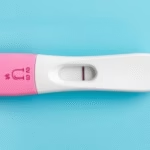Understanding Implantation Bleeding
Implantation bleeding is a light spotting that occurs when a fertilized egg attaches to the lining of the uterus. This event typically happens 6 to 12 days after conception, which is around the time a woman might expect her menstrual period. However, unlike a regular period, implantation bleeding is usually much lighter in color and flow. It can be pinkish or brown rather than bright red. This phenomenon often raises questions, particularly regarding its various characteristics, such as whether or not one can experience blood clots during this process.
The question “Can you have clots during implantation bleeding?” arises frequently among individuals who are trying to conceive. Understanding the implications of blood clots during this period is crucial for those who wish to ensure their reproductive health. Blood clots can range from small flecks of tissue to larger pieces, which can be concerning if seen during implantation bleeding. Recognizing the differences between normal implantation signs and what could indicate a problem is vital for women hoping to achieve or maintain a healthy pregnancy.
Is Implantation Bleeding Normal?
Yes, implantation bleeding is considered a normal occurrence for many women. When a fertilized egg implants itself into the uterine lining, some women may notice light spotting. This is not the same as a menstrual period, which involves a heavier flow and is typically crimson in color. Instead, implantation bleeding can be characterized by a light pink or brownish hue, often with only small amounts of blood. It’s crucial to distinguish between these two types of bleeding to understand how your body operates following conception.
Women may sometimes feel anxious when noticing any form of bleeding during the early stages of pregnancy. Understanding that implantation bleeding is a natural process and not a cause for alarm can help alleviate these concerns. In most cases, the presence of light spotting indicates that the fertilized egg is settling into the uterus properly.
What Are the Common Symptoms of Implantation Bleeding?
Recognizing the symptoms of implantation bleeding can help distinguish it from a regular menstrual period. Here are the common signs to watch for:
- Color of Blood: Implantation bleeding usually appears as light pink or brown rather than the bright red typical of menstruation.
- Flow: The bleeding is usually light in flow and may last only a few hours to a few days.
- Timing: This bleeding occurs roughly 6 to 12 days after conception, which is typically a week before a missed period.
- Cramps: Mild cramping may accompany implantation bleeding, but the discomfort is usually less intense than typical menstrual cramps.
- Other Signs of Pregnancy: Some women may notice early pregnancy symptoms, such as nausea, breast tenderness, or fatigue.
Understanding these symptoms can help reassure women who may be navigating early pregnancy signs for the first time. While any bleeding can cause anxiety, recognizing these characteristics can provide peace of mind.
Can You Experience Clots During Implantation Bleeding?
The primary concern when discussing implantation bleeding is whether blood clots may accompany it. While it is technically possible to notice small clots during implantation, it is somewhat uncommon. Most women experience only light spotting or discharge without significant clotting. Blood clots typically suggest a more complicated situation, possibly indicating miscarriage or other complications.
If bright red blood or large clots are noticed, it is vital to speak with a healthcare provider immediately. These could be signs of a spontaneous abortion or an ectopic pregnancy, both of which require immediate medical attention. Therefore, being mindful of the color, flow, and timing of any bleeding during the implantation phase is crucial for your health.
In summary, while smaller clots may not be a cause for concern during implantation, it is essential to monitor any additional symptoms and consult with healthcare professionals when in doubt. Listening to your body is key during this sensitive time.
Impact of Hormonal Changes
Hormonal fluctuations play a significant role during early pregnancy and can affect bleeding patterns. After implantation occurs, the body begins to produce human chorionic gonadotropin (hCG), a hormone crucial for maintaining pregnancy. Elevated levels of hormones can lead to various symptoms, including changes in bleeding. Some women may experience light spotting as their bodies adjust to these hormonal shifts.
It is important to understand how hormones can affect bleeding patterns, as hormonal changes could lead some women to experience unusual bleeding, perhaps even with slight clotting. Awareness of these changes can be beneficial, allowing women to differentiate between normal hormonal fluctuations and signs that may necessitate medical evaluation.
If you experience significant changes or bleeding patterns, consult with a medical professional to ensure your health and pregnancy status remain stable.
When to Seek Medical Attention
It is essential to know when to seek medical attention if bleeding occurs during pregnancy. Although implantation bleeding is usually harmless, there are certain signs that should never be ignored:
- Heavy Bleeding: If the bleeding is heavier than a normal period.
- Severe Pain: If accompanied by sharp or severe discomfort.
- Bright Red Blood: If the blood is bright red and not light in color.
- Large Clots: Experiencing larger clots that cause concern.
- Persistent Symptoms: If bleeding persists for several days without signs of stopping.
Understanding these red flags is crucial for all pregnant women. Knowing when to reach out for medical help can improve outcomes and ensure a healthy pregnancy.
How to Manage Implantation Bleeding
While there is no specific management required for implantation bleeding, certain practices can help ease concerns:
- Rest: Ensure adequate rest to support your body during this period.
- Hydration: Maintain good hydration, which helps support overall health.
- Monitor Symptoms: Keep track of bleeding patterns and any additional symptoms that may develop.
- Seek Advice: Don’t hesitate to reach out to a healthcare provider for reassurance.
- Reduce Stress: High-stress levels can lead to complications in pregnancy, so in case of anxiety, consider relaxation techniques.
Managing concern about bleeding during early pregnancy is vital. It is essential to remain calm and collect information about your body and any changes you may be experiencing. Keeping an open line of communication with healthcare professionals can provide peace of mind.
Common Misconceptions About Implantation Bleeding
There are several misconceptions about implantation bleeding that can lead to misunderstandings. Here’s a look at some common myths:
- It’s the Same as a Menstrual Period: Many confuse implantation bleeding with a typical period. However, implantation bleeding is lighter and shorter.
- It Always Happens: Not every woman experiences spotting during implantation, as it occurs in only a subset of pregnancies.
- It’s Always a Positive Sign: While implantation bleeding often indicates pregnancy, not all women who experience bleeding are pregnant.
- Clots are Normal: Smaller clots may occur, but larger clots should prompt medical consultations.
- Only Occurs After IVF: Implantation bleeding can also happen with natural conception and not solely after assisted reproductive techniques.
Being aware of these misconceptions can help women navigate early pregnancy signs and avoid unnecessary worry. It is crucial to stay informed and understand your body’s responses to pregnancy changes.
Final Thoughts
In summary, understanding implantation bleeding and its characteristics is essential for women navigating early pregnancy. It is a common occurrence that signifies a fertilized egg embedding itself into the uterine lining. While minor bleeding may occur, recognizing the difference between normal implantation and potential complications is crucial.
It is generally uncommon to experience significant clotting during implantation bleeding. Small flecks of tissue may appear in some cases, but if any concerns arise, it is essential to seek medical professionals’ guidance. Being aware of the symptoms, including color and flow of blood, can help reassure women experiencing early signs of pregnancy.
Awareness of hormonal changes is also vital because they play an essential role in implantation and can cause unusual symptoms. It is imperative to know when to seek medical attention when experiencing unusual bleeding patterns. Understanding common misconceptions can significantly ease anxiety and foster confidence as women navigate this exciting yet challenging time.
Frequently asked questions can serve as a great resource for women attempting to educate themselves about embryo implantation and the likelihood of bleeding. Knowing the facts can turn anxiety into knowledge, enabling women to approach their health proactively.
- What color is implantation bleeding? Implantation bleeding usually appears as light pink or brown rather than bright red.
- How long does implantation bleeding last? Implantation bleeding typically lasts from a few hours to a few days.
- Is implantation bleeding common? Yes, many women experience implantation bleeding, but it is not universal.
- Can you have clots during implantation bleeding? It is possible to have small clots, but larger clots should prompt medical consultation.
- What should I do if I am concerned about my bleeding? If you have any concerns, reach out to your healthcare provider immediately.
Further Reading
What Type of Psychotherapy Is Best for Anxiety?







